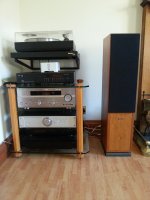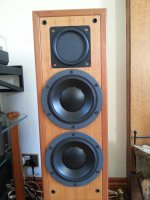Can the miniDSP be used as a pre-amp and act as a volume control for the system?
Ofc it can, but it's kinda brute force and in that case you'd get better performance if you remove your source from the chain, use digital input to the MiniDSP and use it as source instead =)
It can use an external volume control, but you have to add that yourself. It does have a digital input which, as stated above, is the better option, especially for lower noise.
Yeah I do this with mine.
I have the 2x8,
With Digi-FP - for digital inputs, (3 in and 3 outs)
And Vol - FP, which controlling the volume with a knob, and has lights for the inputs, and lights for 4 different settings (seen people have one for movies, music, neighbours away etc)
the Vol-FP also has a remote sensor (an extra one i think) which works with sony remotes, so my old tv remote controls volume, input and settings.
I love mine, quite easy, cheap-ish. Have yet to implement room correction, but have their UMIK mic too, so you can measure and auto-correct.
I have the 2x8,
With Digi-FP - for digital inputs, (3 in and 3 outs)
And Vol - FP, which controlling the volume with a knob, and has lights for the inputs, and lights for 4 different settings (seen people have one for movies, music, neighbours away etc)
the Vol-FP also has a remote sensor (an extra one i think) which works with sony remotes, so my old tv remote controls volume, input and settings.
I love mine, quite easy, cheap-ish. Have yet to implement room correction, but have their UMIK mic too, so you can measure and auto-correct.
Last edited:
Mini DSP with Abbeys
Hi Earl,
Do you recommend mini-DSP to be used with Abbeys from a sonic perspective? I understand one has to factor in $$/extra costs for going active.
Looking forward to your Abbey v2 🙂
Regards,
Kishore
Hi Earl,
Do you recommend mini-DSP to be used with Abbeys from a sonic perspective? I understand one has to factor in $$/extra costs for going active.
Looking forward to your Abbey v2 🙂
Regards,
Kishore
Sonically I would not expect a huge effect. It would take some serious testing to determine this subjectively. But there are some small but significant improvement that can be had with active. I sell the active and passive for the same price, so its just the cost of another amp that matters. I don't recommend expensive amps so this is a rather small , but incremental, cost. The biggest factor for me (I still use passive) is that active is hard to do with a receiver.
Active with an AV reciever
Hi Earl,
I just recently had a great result using an 4 year old Yamaha AV receiver and an 8 year old Audiolab power amp ( worth approx. £150 for the pair) to actively power and DSP crossover a pair of Dynaudio Contour Mk2's.
I used the Yamahas DSP crossover at 200Hz ( 24dB slopes I think) and the pre outs to connect the customers Musical fidelity amp to power the BMR's, and the Audiolab powers the 6.5 inch Dynaudio drivers.
End result is really remarkably good.
Before the mod I couldn't get £300 for the Dynaudio speakers...After installing two BMR's and including the two amps I got £1,500....!
The customer is a top session musician and used to very high grade studio sound, he is blown away and has given me a great reference / introduction to some other guys.
Buying up classic passive speakers and older AV amps and power amps could be a great little add on your trade in business!
Cheers
Derek.
Hi Earl,
I just recently had a great result using an 4 year old Yamaha AV receiver and an 8 year old Audiolab power amp ( worth approx. £150 for the pair) to actively power and DSP crossover a pair of Dynaudio Contour Mk2's.
I used the Yamahas DSP crossover at 200Hz ( 24dB slopes I think) and the pre outs to connect the customers Musical fidelity amp to power the BMR's, and the Audiolab powers the 6.5 inch Dynaudio drivers.
End result is really remarkably good.
Before the mod I couldn't get £300 for the Dynaudio speakers...After installing two BMR's and including the two amps I got £1,500....!
The customer is a top session musician and used to very high grade studio sound, he is blown away and has given me a great reference / introduction to some other guys.
Buying up classic passive speakers and older AV amps and power amps could be a great little add on your trade in business!
Cheers
Derek.
Attachments
Buying up classic passive speakers and older AV amps and power amps could be a great little add on your trade in business!
Cheers
Derek.
Thanks, but my goal is just to retire without all of my work going down the drain. Fixing up old loudspeakers hardly helps that goal! 😛
Retire...Never!
I hear that!
But please don't retire too soon....It would be so dull round hear without the good Doctor!
Cheers
D.
I hear that!
But please don't retire too soon....It would be so dull round hear without the good Doctor!
Cheers
D.
I have no intention of shutting up! Just the physical labor part. I tore my shoulder cup and without drugs I can't do any manual labor. But that doesn't affect my jaws or my fingers 😛
Can the miniDSP be used as a pre-amp and act as a volume control for the system?
That's the basic idea, but using three elements is simply to allow a patent. two works just as well.
Interesting. When you first mentioned CLD bracing I assumed you were talking about what I call "Dodd braces," i.e. solid wooden braces connected to the relevant panels with a damping mastic. (I call them Dodd braces because I first saw them on Mark Dodd's old Tannoy DMT studio monitor cabinets, and they recently popped up again on his recent KEF LS50. (See [url=LS50 "White Paper", at 11, picture at 18.)
So your braces are now basically a composite of two dowels with a damping layer between them, and only one dowel touching each side of the cabinet?
I hear that!
But please don't retire too soon....It would be so dull round hear without the good Doctor!
Cheers
D.
I 2nd the motion
So your braces are now basically a composite of two dowels with a damping layer between them, and only one dowel touching each side of the cabinet?
I don't think that the details are important, but that's basically correct. Dodd and I both found that cross bracing works well, but that damping that brace works even better.
@Pallas,
can you repost that KEF link.
Sorry, dunno what happened. Let's try again. http://www.kefamerica.com/july12/LS50 White Paper.pdf
"a waveguide this large will have trouble above about 8 kHz."An 18 " waveguide will just reach down to about 1 kHz. To go down to 500 Hz would require the mouth diameter to double (half the frequency double the radius). A 36" waveguide is going to be hard to make unless you are very well equipped. And then you will certainly need a second one as a waveguide this large will have trouble above about 8 kHz. To me, 18" is optimal because that is the only solution that allows for a single crossover point low enough to not be an issue.
Can you please explain why is that and what means "trouble"? How does the increasing size of the waveguide affect its "troubleness" in the highs? (~ dependency of size to upper frequency).
I think the point is that with a 36" wide waveguide you won't be using a 1" exit CD (unless it's a synergy horn)........more like 2" which isn't going to play as well as a 1" in the top octaves. So then you need another wg.
Sure, but my question was, if the waveguide itself has such problems being that huge.
I am intending to build a wg as big as I can fit into the CNC machine, 2" throat. But before I waste several hours of milling time I just wanted to know if it is a complete nonsense to build such thing that is going down to 500 Hz or just an overkill...
And yes, I've read several times, that optimal size is 15-18" and bigger is not really needed, I just wanted to try it with BMS4590/4592 which I hope I can borrow for measuring 🙂
I am intending to build a wg as big as I can fit into the CNC machine, 2" throat. But before I waste several hours of milling time I just wanted to know if it is a complete nonsense to build such thing that is going down to 500 Hz or just an overkill...
And yes, I've read several times, that optimal size is 15-18" and bigger is not really needed, I just wanted to try it with BMS4590/4592 which I hope I can borrow for measuring 🙂
If I've understood correctly one of the reasons the Summa is so large is that Geddes has 110 + dB as his goal SPL. If you don't need that ( Your ears will thank you! 😀 ) then you could get away with an 8"-10" and a smaller waveguide. You could probably get a coaxial speaker to make the integration easier, make wavefront more uniform and save space.
This is entirely false.
The reason that the waveguide is big is to get good directivity control down to 700-800 Hz. Then the reason that the woofer is big is so that its directivity will match that of the waveguide at the crossover.
I use more efficient loudspeakers in order to minimize the thermal modulation (not to be confused with thermal compression) for good dynamics - even at lower listening levels.
The fact that they are extremely clean at 110 dB is nice, but was not really the goal (and almost never used.) Your suggestion - been there done that - will not result in performance anywhere near that of a NS15 or any of my speakers for that matter.
I have tried exactly what is being looked at here. I found the tradeoff to go dipole were not worth the advantages. And, as can be seen in my PolarMap software, the performance of coaxs never really live up to the theoretical advantages.
Last edited:
- Status
- Not open for further replies.
- Home
- Loudspeakers
- Multi-Way
- 15" OSWG & 15" OB 4 ME

